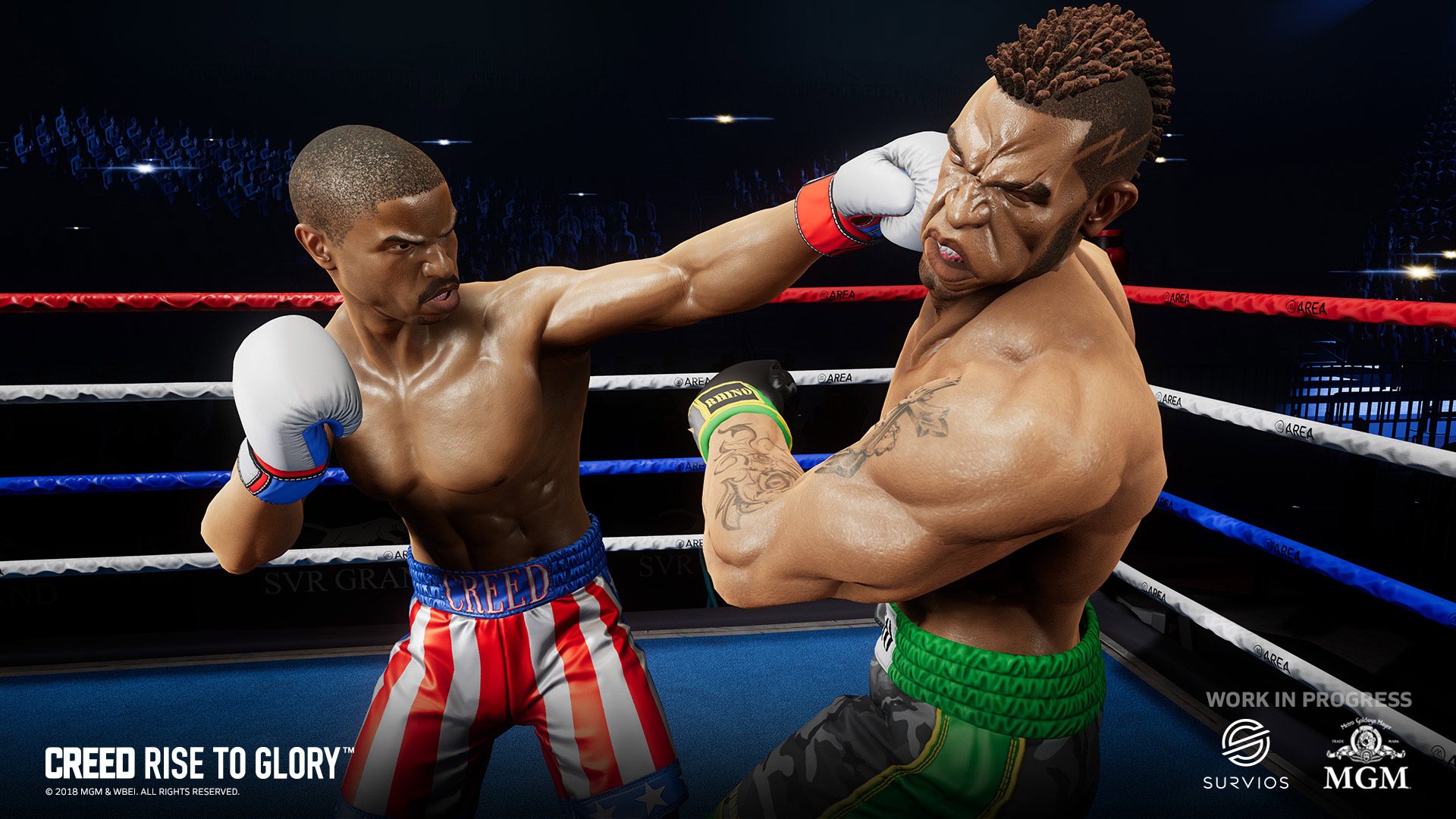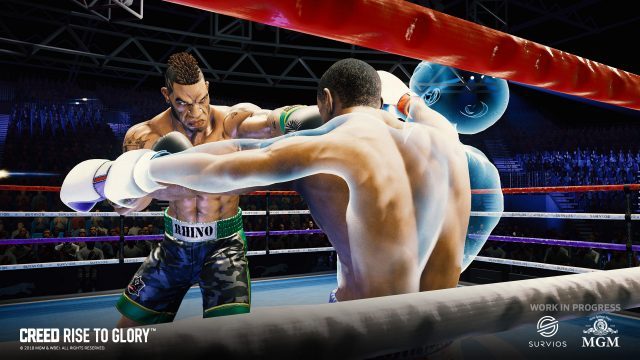CREED: Rise to Glory is a boxing game that aims to get you up and sweating with what promises to deliver the Rocky-style underdog victory that couch jockies like me have always dreamed about. While it’s lighter on story than it probably could have been, it delivers some heavy-hitting game mechanics that do pretty well considering you’re effectively punching at air.
Creed: Rise to Glory Details:
Developer: Survios
Available On: Steam (Vive, Rift,), Oculus Store (Rift), PlayStation Store (PSVR)
Reviewed On: Oculus Rift, HTC Vive
Release Date: September 25th, 2018
Gameplay
There’s not much to know about the story behind Creed: Rise to Glory. Like in the films, you follow series protagonist Adonis “Hollywood” Creed, the son of Apollo Creed, and fight to become the champ.
Story elements are told through a radio program playing in the gym, which serves as your sanctuary where you can train before fights and hear a little bit about the boxing world outside of the gym’s four walls. A single flashback of you punching out a bouncer and presumably losing a love interest are light padding to the game’s main event: dodging and making sure your stamina isn’t too low so you can land effective punches during matches. And while I felt the story definitely could have played out to a grander, more dramatic effect with a longer arc than what its six primary enemies provided, the most important things are strong fundamentals and being engaging enough to revisit, which is clearly the case in Creed: Rise to Glory.

As someone who’s never boxed before, I can’t really say with much certainty how true Creed VR is to the actual sport, but it appears to have been game-ified well into arcade territory. The Rocky films, and by extension the Creed films, are fantastical fights that probably could never happen in reality anyway. Like with many sports films, the technicality of the sport is mostly lost in those big dramatized moments that challenge the main character, and help them come to a hard-won resolution. Stepping into the ring with the lights, the crowd, and the announcer, it easily matched up to my already warped expectations of how boxing is portrayed in film—that much I can say with confidence; I felt like I was in a movie, and it was awesome.
Iconic training montages with Rocky Balboa, voiced with a convincing-enough impression of Sylvester Stallone, prefaced most fights, giving you that all important cinematic touchstone.
Introducing what Survios calls ‘Phantom Melee Technology’, Creed uses a sort of body desynchronization when either your stamina is low, or when you’re staggered from a powerful punch. Low stamina is indicated by the color of your gloves, which will flash red to make sure you know your punches will be slower than your actual physical ability to shadow box. This keeps you on the guard more than you might otherwise be, as the only way to recuperate stamina is by holding you hands still. Enemies will also dodge and block your hits too, making them more than just simple punching bags.
Getting staggered happens in two stages. A powerful punch can put you in a quick out-of-body experience that requires you to match up your hands to two targets, allowing you to pop back into the fight.
More devastating punches can knock you way out of the ring, requiring you to ‘run’ back and jump back into your body. These are fun and truly creative ways of making you feel like you’re hanging on to a bare thread in the more difficult matches.
A few methods of activating slow motion sequences really drive home the cinematic nature of the game, as you dodge a punch or land a big hit that places temporary target’s on your opponent’s body.
All of these systems work extremely well, but the learning curve is somewhat steep. There is no visible HP or stamina bar, so spending some extra time in training is probably a good thing so you can start to really feel out how many hits you can take and how many you can give before throwing yourself at the actual matches.
I beat the campaign mode in about an hour an a half on normal difficulty, although that was stretched out over several sessions simply based on my own admittedly out-of-shape cardio abilities. It’s easy to see using Creed: Rise to Glory in an actual cardio routine to get less than active people (like me) up from the chair and getting their heart pumping. I felt enemies weren’t terribly varied in the attack styles, as it seems difficulty is mostly based more on the NPC’s individual punch strength and HP.
While I was left somewhat disappointed by the shortness of the campaign mode, thankfully you can mix and match enemies, gyms, and boxing locales in free play. Another big addition recently announced to arrive on all platforms is PvP online multiplayer. Online multiplayer presents a good opportunity to really turn the technical difficulty up, as live players exploit tactics that NPCs simply can’t think of, like running around the ring and going for a drive-by punch. These online battles are intense, and provided some of my most tiring battles.
Immersion
While at times on the cartoonish side, character models and their animations are very well-done and can be genuinely intimidating too. Seeing a near seven foot-tall guy trying to hit me in the face isn’t something I’m really used to, and even though nothing bad can happen outside of accidentally punching a wall/TV/monitor, there are some moments before the fight when you subconsciously size up the competition.
Impressive and realistic set pieces help ground you in the world, although it’s clear Creed: Rise to Glory is definitely bucking up against some of the inherent limitations of the current state of VR. Without any bodily feedback outside of the controller’s haptics, it’s difficult to completely immerse yourself in the act of dodging and blocking, two things that require more than visual cues to accomplish. Oftentimes I had my gloves up, obscuring my vision, and without force feedback (which at this point isn’t possible), you just have to rely on the controller’s buzzy haptics and the game’s visual cues to tell if you’ve hit your opponent or pulled your punch too early. That said, it’s great to know that Creed VR has entirely bypassed the ‘waggle simulator’ trend of earlier titles, as it not only requires you to punch quickly, but do it accurately for the sake of lost stamina.
The game’s AI is pretty darn good. At moments I could feel the AI sussing out my head’s position and aiming accurately for my noggin despite I had dodged an earlier punch. NPCs feel mostly solid, although you can actually run through them if you want.
While based mostly on room-scale movement, there are moments when you need to artificially move from point A to point B, including when you square off at the beginning of the fight and during moments when you’re knocked out and have to run back to your body to continue the fight. Moving in the game is accomplished by swinging your arms while holding down the applicable buttons on each controller, which sends you sliding forward. Artificial locomotion is generally useless during fights, so it usually comes down to standing in place and punching it out like rock’em sock’em robots, albeit with a little more finesse and dodging/blocking abilities.
Comfort
Both room-scale and the game’s only other locomotion scheme, detailed above, are extremely comfortable ways of moving around VR.
That said, this is a very physical standing game that will get your heart beating, and definitely get you sweating through the padding on your headset if you’re not careful. That’s not so much a knock on the game’s comfort rating as it is an advisory to plan ahead. Pop on some gym shorts for an extended session, because you’ll soon be huffing and puffing with all the dodging, bobbing and punching you’ll be doing.
Like with many more physical VR games, there’s a risk of hyperextending your arms alla tennis elbow, so it may be best to take frequent breaks if you have some pre-existing joint issues.
Summary: ‘CREED: Rise to Glory’ may be light on story and features a relatively short campaign, but it certainly packs a heavy punch with some clever and well-developed boxing mechanics and a cinematic vibe that really nails the underdog boxer source material. Since the meat of the game features minimal UI, you’re oftentimes left guessing at how much health you have left. Combined with the fact that you don’t inherently know how powerful an enemy is, it becomes somewhat of a guessing game at first until you’ve gotten more experience in training and in freeplay mode.
Gameplay: 7.5 | Immersion: 7.5 | Comfort: 9



